trailer VOLVO S80 2002 Owners Manual
[x] Cancel search | Manufacturer: VOLVO, Model Year: 2002, Model line: S80, Model: VOLVO S80 2002Pages: 111, PDF Size: 2.74 MB
Page 22 of 111
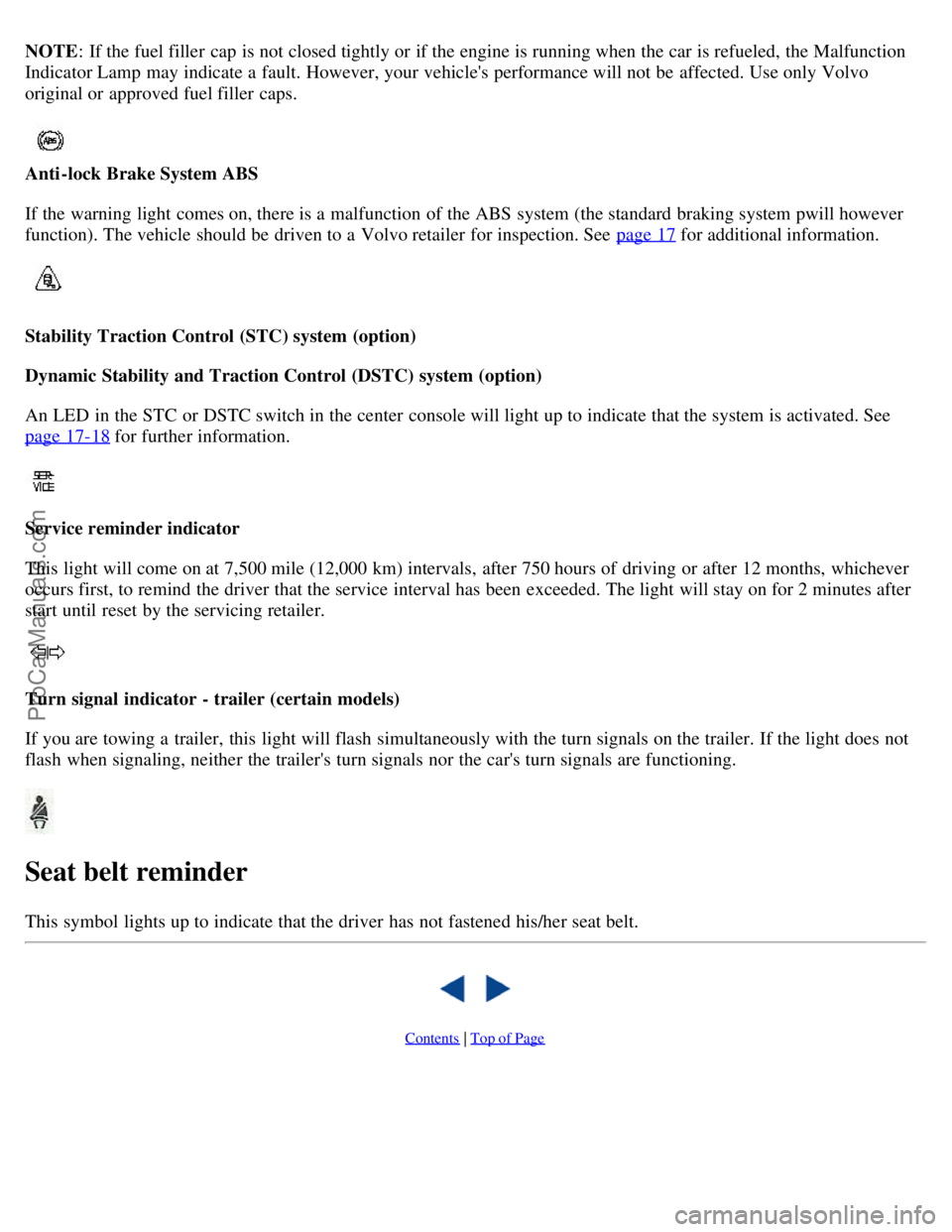
NOTE: If the fuel filler cap is not closed tightly or if the engine is running when the car is refueled, the Malfunction
Indicator Lamp may indicate a fault. However, your vehicle's performance will not be affected. Use only Volvo
original or approved fuel filler caps.
Anti-lock Brake System ABS
If the warning light comes on, there is a malfunction of the ABS system (the standard braking system pwill however
function). The vehicle should be driven to a Volvo retailer for inspection. See page 17
for additional information.
Stability Traction Control (STC) system (option)
Dynamic Stability and Traction Control (DSTC) system (option)
An LED in the STC or DSTC switch in the center console will light up to indicate that the system is activated. See
page 17-18
for further information.
Service reminder indicator
This light will come on at 7,500 mile (12,000 km) intervals, after 750 hours of driving or after 12 months, whichever
occurs first, to remind the driver that the service interval has been exceeded. The light will stay on for 2 minutes after
start until reset by the servicing retailer.
Turn signal indicator - trailer (certain models)
If you are towing a trailer, this light will flash simultaneously with the turn signals on the trailer. If the light does not
flash when signaling, neither the trailer's turn signals nor the car's turn signals are functioning.
Seat belt reminder
This symbol lights up to indicate that the driver has not fastened his/her seat belt.
Contents | Top of Page
ProCarManuals.com
Page 48 of 111

2 0 0 2
VOLVO S80
Chapter 6 - Starting and driving
pg. 65 Starting and driving
Fuel requirements66
Refueling68
Starting the engine69
Automatic transmission70
Driving economy74
Points to remember75
Roof racks/load carriers76
Emergency towing77
Vehicle towing information78
Towing a trailer79
Jump starting82
Winter driving83
Long distance trips84
Three-way catalytic converter85
pg. 66 Fuel requirements
Fuel requirements
Octane rating
Volvo engines are designed for optimum performance on unleaded premium gasoline with an octane rating AKI of 91,
or above. AKI (ANTI KNOCK INDEX) is an average of the Research Octane Number, RON, and the Motor Octane
Number, MON. (RON + MON/2). The minimum octane requirement is AKI 87 (RON 91).
ProCarManuals.com
Page 53 of 111
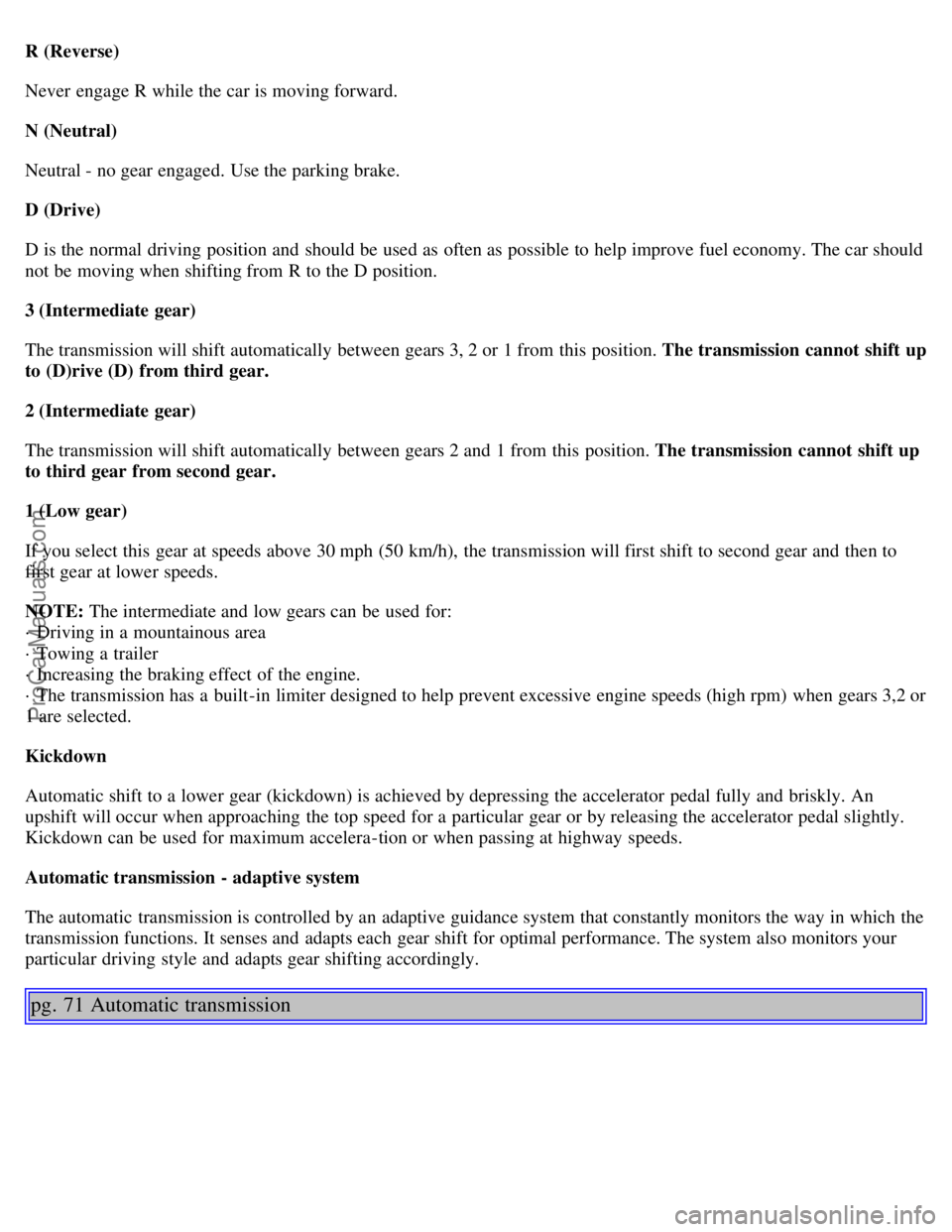
R (Reverse)
Never engage R while the car is moving forward.
N (Neutral)
Neutral - no gear engaged. Use the parking brake.
D (Drive)
D is the normal driving position and should be used as often as possible to help improve fuel economy. The car should
not be moving when shifting from R to the D position.
3 (Intermediate gear)
The transmission will shift automatically between gears 3, 2 or 1 from this position. The transmission cannot shift up
to (D)rive (D) from third gear.
2 (Intermediate gear)
The transmission will shift automatically between gears 2 and 1 from this position. The transmission cannot shift up
to third gear from second gear.
1 (Low gear)
If you select this gear at speeds above 30 mph (50 km/h), the transmission will first shift to second gear and then to
first gear at lower speeds.
NOTE: The intermediate and low gears can be used for:
· Driving in a mountainous area
· Towing a trailer
· Increasing the braking effect of the engine.
· The transmission has a built-in limiter designed to help prevent excessive engine speeds (high rpm) when gears 3,2 or
1 are selected.
Kickdown
Automatic shift to a lower gear (kickdown) is achieved by depressing the accelerator pedal fully and briskly. An
upshift will occur when approaching the top speed for a particular gear or by releasing the accelerator pedal slightly.
Kickdown can be used for maximum accelera-tion or when passing at highway speeds.
Automatic transmission - adaptive system
The automatic transmission is controlled by an adaptive guidance system that constantly monitors the way in which the
transmission functions. It senses and adapts each gear shift for optimal performance. The system also monitors your
particular driving style and adapts gear shifting accordingly.
pg. 71 Automatic transmission
ProCarManuals.com
Page 57 of 111

Economical driving conserves natural resources
Better driving economy may be obtained by thinking ahead, avoiding rapid starts and stops and adjusting the speed of
your vehicle to immediate traffic conditions. Observe the following rules:
· Bring the engine to normal operating temperature as soon as possible by driving with a light foot on the accelerator
pedal for the first few minutes of operation. A cold engine uses more fuel and is subject to increased wear.
· Whenever possible, avoid using the car for driving short distances. This does not allow the engine to reach normal
operating temperature.
· Drive carefully and avoid rapid acceleration and hard braking.
· Do not exceed posted speed limits.
· Avoid carrying unnecessary items (extra load) in the car.
· Maintan correct tire pressure. Check tire pressure regularly (when tires are cold).
· Remove snow tires when threat of snow or ice has ended.
· Note that roof racks, ski racks, etc., increase air resistance and also fuel consumption.
· Avoid using automatic transmission kickdown feature unless necessary.
· However, at higher driving speeds, fuel consumption will be lower with the air conditioning on and the windows
closed than with the air conditioning off and the windows open.
· Using the onboard trip computer's fuel consumption modes can help you learn how to drive more economically.
Other factors which decrease gas mileage are:
· Worn or dirty spark plugs
· Incorrect spark plug gap
· Dirty air cleaner
· Dirty engine oil and clogged oil filter
· Dragging brakes
· Incorrect front end alignment
Some of the above mentioned items and others are checked at the standard Maintenance Service intervals.
NOTE: Vehicles equipped with automatic transmissions should use (D)rive as often as possible and avoid using
"kickdown" to help improve fuel economy.
Cooling system
The risk for engine overheating is greatest, especially in hot weather, when:
· Towing a trailer up steep inclines for prolonged periods at wide open throttle and low engine rpm.
· Stopping the engine suddenly after high speed driving (so-called "after-boiling" can occur).
· To avoid overheating, the following rules should be followed: Do not drive for prolonged periods at engine speeds
above 4500 rpm if you are towing a trailer in hilly terrain.
· Reduce speed when towing a trailer up long, steep inclines. The risk of overheat -ing can be reduced by switching off
the air conditioning system for a short time.
· Do not let the engine idle unnecessarily for prolonged periods.
· Do not mount auxiliary lamps in front of the grill. When the risk of overheating is imminent, or in the event of
overheating (the temperature gauge goes repeatedly into, or stays continual-ly in, the red section), the following
precau-tions should be taken:
· Switch off the air conditioning system.
· Pull off the road, away from traffic, stop the car and put the gear selector into Park. Do not stop the engine!
· Switch the heater to full (maximum) position. Increase the engine speed to approx. 2000 rpm (twice idling speed)
until the temperature begins to drop.
· If the warning light in the center of the instrument panel is red, and the message "Coolant level lo stop engine" is
displayed, switch off the engine as soon as possible.
ProCarManuals.com
Page 72 of 111
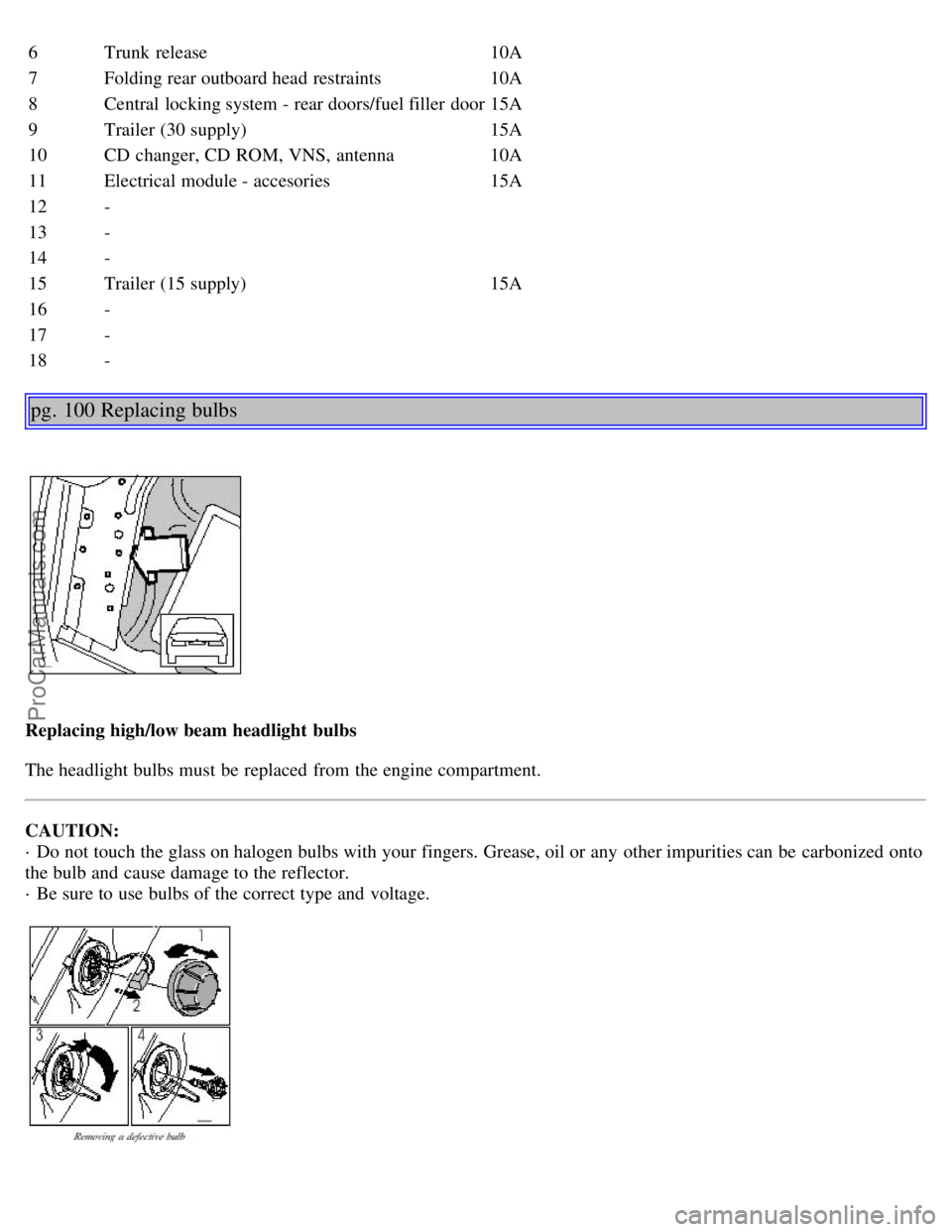
6Trunk release 10A
7Folding rear outboard head restraints 10A
8 Central locking system - rear doors/fuel filler door 15A
9 Trailer (30 supply) 15A
10 CD changer, CD ROM, VNS, antenna 10A
11 Electrical module - accesories 15A
12 -
13 -
14 -
15 Trailer (15 supply) 15A
16 -
17 -
18 -
pg. 100 Replacing bulbs
Replacing high/low beam headlight bulbs
The headlight bulbs must be replaced from the engine compartment.
CAUTION:
· Do not touch the glass on halogen bulbs with your fingers. Grease, oil or any other impurities can be carbonized onto
the bulb and cause damage to the reflector.
· Be sure to use bulbs of the correct type and voltage.
ProCarManuals.com
Page 73 of 111

To remove a defective bulb:
· Switch off the ignition.
· Open the hood.
· Remove the plastic cover over the bulb (1) by turning it counterclockwise.
· Remove the connector (2).
· Loosen the retaining spring (3) by first moving it to the right and then moving it down, out of the way.
· Pull out the defective bulb. Note the position of the guide lug on the base of the bulb (4).
To install a new bulb:
· Insert the new bulb, without touching the glass, with the guide lug upward (1). The bulb will only seat properly in
this position.
· Move the retaining spring up and push it slightly to the left until it seats properly (2).
· Press the connector into place on the bulb (3).
· Reinstall the plastic cover and turn it clockwise until it is correctly in place (4). "TOP" must be upward.
NOTE: If the vertical aim of your headlights needs to be adjusted for any reason (e.g., towing a trailer for extended
periods), this should be done by an authorized Volvo retailer.
pg. 101 Replacing bulbs
Front parking lights
· Switch off the ignition.
· Remove the plastic cover over it the high beam bulb by turning it counterclockwise.
· Pull out the bulb and its socket. Replace the bulb.
· Press the bulb and its socket back into place.
ProCarManuals.com
Page 81 of 111
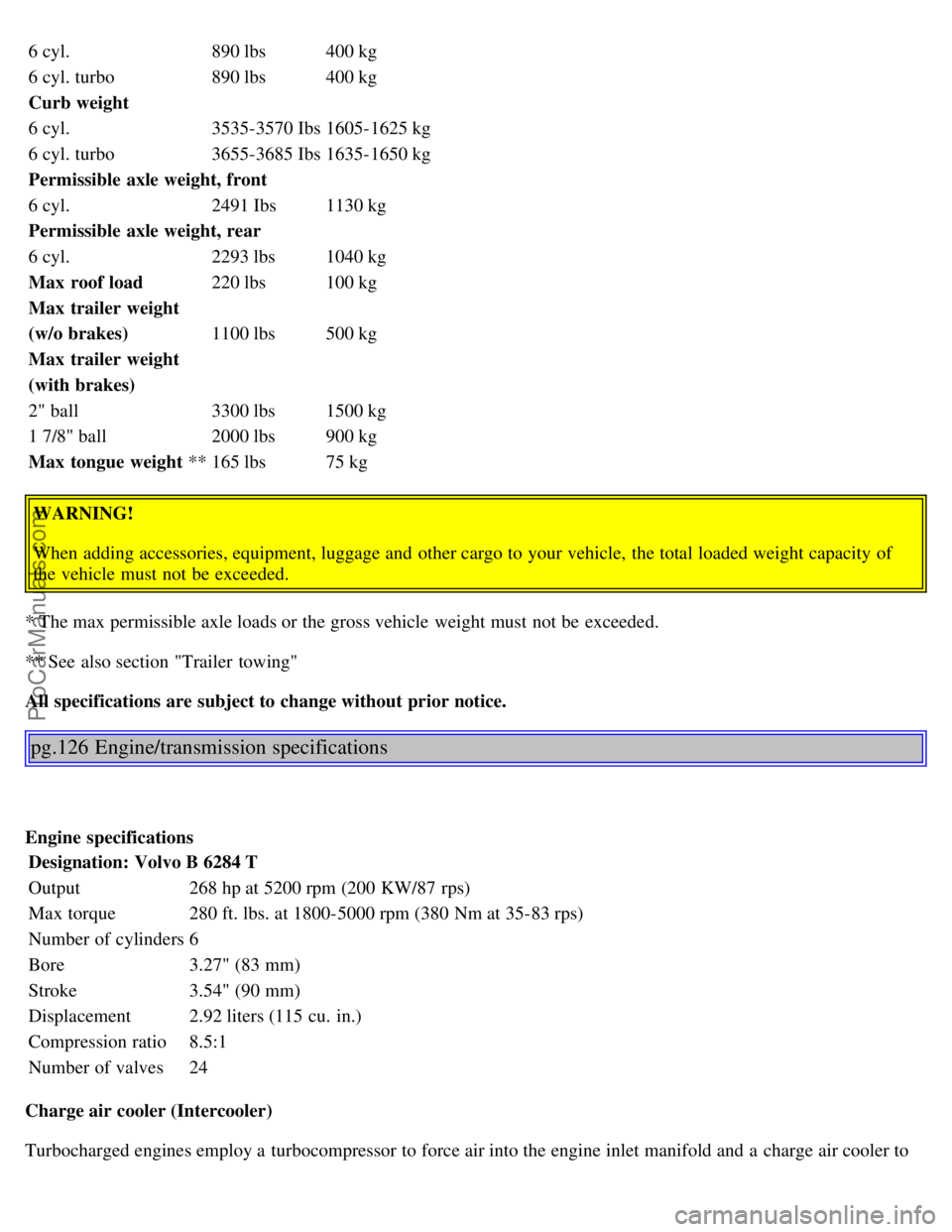
6 cyl.890 lbs400 kg
6 cyl. turbo 890 lbs400 kg
Curb weight
6 cyl. 3535-3570 Ibs1605-1625 kg
6 cyl. turbo 3655-3685 Ibs1635-1650 kg
Permissible axle weight, front
6 cyl. 2491 Ibs1130 kg
Permissible axle weight, rear
6 cyl. 2293 lbs1040 kg
Max roof load 220 lbs100 kg
Max trailer weight
(w/o brakes) 1100 lbs500 kg
Max trailer weight
(with brakes)
2" ball 3300 lbs1500 kg
1 7/8" ball 2000 lbs900 kg
Max tongue weight **165 lbs 75 kg
WARNING!
When adding accessories, equipment, luggage and other cargo to your vehicle, the total loaded weight capacity of
the vehicle must not be exceeded.
* The max permissible axle loads or the gross vehicle weight must not be exceeded.
** See also section "Trailer towing"
All specifications are subject to change without prior notice.
pg.126 Engine/transmission specifications
Engine specifications Designation: Volvo B 6284 T
Output 268 hp at 5200 rpm (200 KW/87 rps)
Max torque 280 ft. lbs. at 1800-5000 rpm (380 Nm at 35-83 rps)
Number of cylinders 6
Bore 3.27" (83 mm)
Stroke 3.54" (90 mm)
Displacement 2.92 liters (115 cu. in.)
Compression ratio 8.5:1
Number of valves 24
Charge air cooler (Intercooler)
Turbocharged engines employ a turbocompressor to force air into the engine inlet manifold and a charge air cooler to
ProCarManuals.com
Page 106 of 111

Shiftlock..........69, 70, 72
Side direction indicator - replacing..........103
Side impact airbag system (SIPS)..........8
Side marker lights - replacing..........105
Sideview mirrors..........36
Sideview mirrors - folding ........27
Sideview mirrors - heated..........33
Sideview mirrors - memory function..........36
Snow chains..........89
Snow tires..........89
Spare tire.......... 53, 90
Spark plugs..........128
Specifications..........126
Speed -sensitive power steering..........75
SRS..........6
SRS diagnostic system..........24
Stability Traction Control (STC)..........17, 27
Start inhibitor (immobilizer)..........56, 69
Starting the engine..........69
Steering wheel adjustment ........ 32
Steering wheel lock..........32
Storage compartment in center console..........52
Storage compartments..........51
Studded tires..........89
Sun blinds..........38
Sun roof..........37
Supplemental Restraint System..........4, 24
Suspension..........128
Switches in center console ........ 27
T
Tachometer..........23
Tail light bulbs - replacing ........ 102
Temperature gauge..........23
Temporary spare tire..........90
Text window..........26
Three-way catalytic converters..........85
Tire pressure..........90
Tires..........75, 88 - 91
Tires - changing..........92, 93
Tool bag..........53
Towing a trailer..........79
Towing eyelet..........77
Towing the car..........77, 78
Trailer towing..........79
ProCarManuals.com
Page 107 of 111
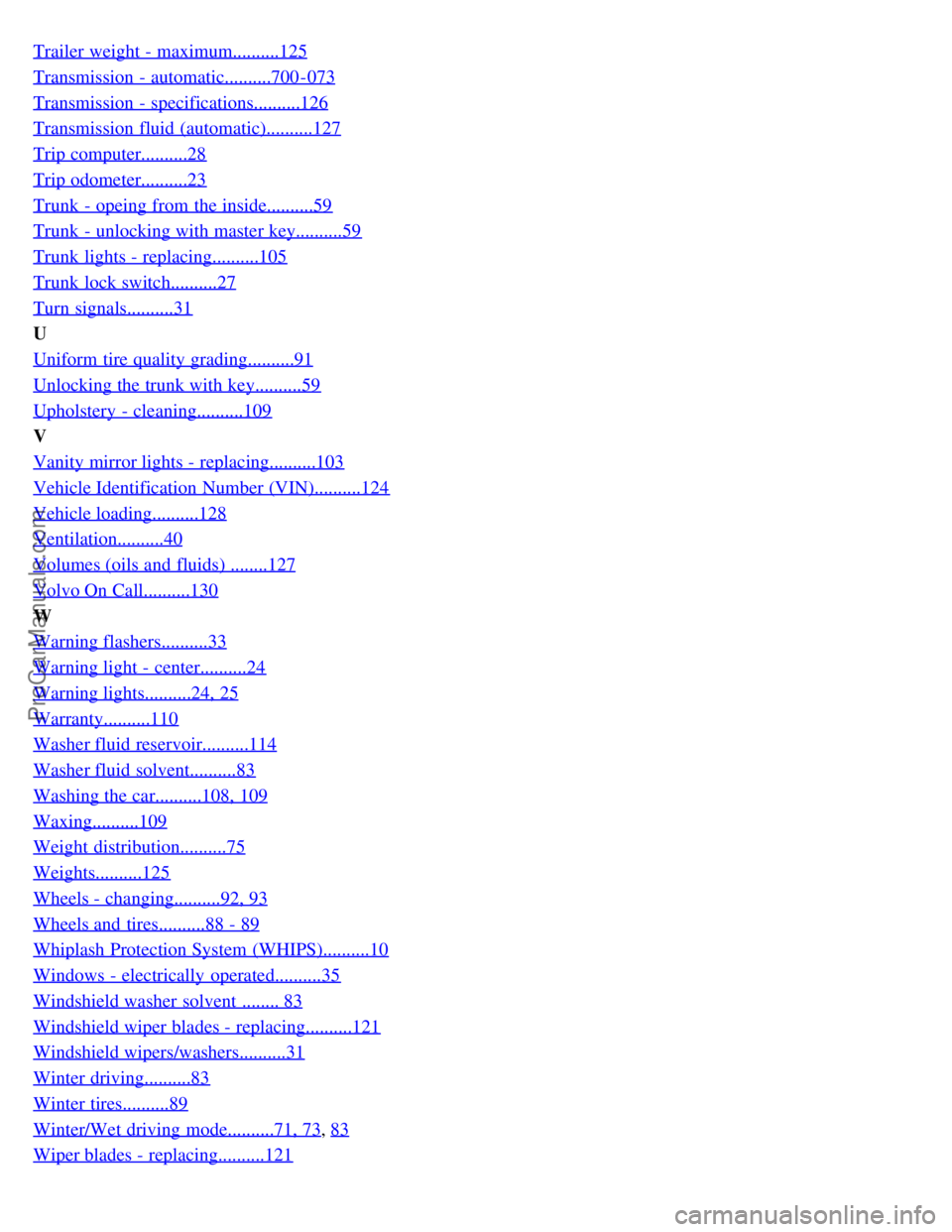
Trailer weight - maximum..........125
Transmission - automatic..........700 -073
Transmission - specifications..........126
Transmission fluid (automatic)..........127
Trip computer..........28
Trip odometer..........23
Trunk - opeing from the inside..........59
Trunk - unlocking with master key..........59
Trunk lights - replacing..........105
Trunk lock switch..........27
Turn signals..........31
U
Uniform tire quality grading..........91
Unlocking the trunk with key..........59
Upholstery - cleaning..........109
V
Vanity mirror lights - replacing..........103
Vehicle Identification Number (VIN)..........124
Vehicle loading..........128
Ventilation..........40
Volumes (oils and fluids) ........127
Volvo On Call..........130
W
Warning flashers..........33
Warning light - center..........24
Warning lights..........24, 25
Warranty..........110
Washer fluid reservoir..........114
Washer fluid solvent..........83
Washing the car..........108, 109
Waxing..........109
Weight distribution..........75
Weights..........125
Wheels - changing..........92, 93
Wheels and tires..........88 - 89
Whiplash Protection System (WHIPS)..........10
Windows - electrically operated..........35
Windshield washer solvent ........ 83
Windshield wiper blades - replacing..........121
Windshield wipers/washers..........31
Winter driving..........83
Winter tires..........89
Winter/Wet driving mode..........71, 73, 83
Wiper blades - replacing..........121
ProCarManuals.com